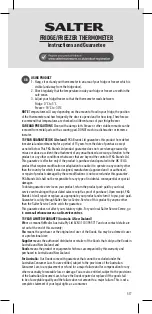
95C-10903-1
Check Out
Turn on power. Raise the temperature setting to energize
the heating contact and break the cooling contact. The
HVAC equipment should begin heating or stop cooling, as
appropriate.
NOTE: For T451A and T651A models only, the thermostat
will call for heat (disable cooling) when the setpoint dial
is at full counter-clockwise position. This setting is the
phase change point of the diaphragm’s vapor fill and is
independent of calibration. To de-energize the load(s),
turn off power at the circuit breaker panel, or add a
separate disconnect switch.
Altitude Compensation
T451, T651 units are calibrated at the factory for accuracy
at 500 feet above sea level. No recalibration is needed if the
switch operates at the same temperature indicated on the
thermometer.
The vapor-filled diaphragm sensor is affected by barometric
pressure and altitude. Deviations up to ± 1°F (1/2°C) are
within normal operation. Control point drops 2°F every
1000 ft. (1°C/300 m) above sea level. See Fig. 3 for
recommended action.
T451, T651 MOTOR-RATED PRECISION THERMOSTATS
INSTALLATION
Fig. 3 — Altitude Correction
To Recalibrate
1. Remove cover. Set the tab on setpoint knob to the leftmost
radial mark visible on top of the triangular arm that holds
the dual diaphragm sensor (Fig. 4).
2. Without rotating the knob, remove it from the thermostat
by pulling straight out, while holding the base against
the wall.
3. Now, rotate the removed setpoint knob clockwise by the
amount of temperature error. Each mark on the triangular
arm represents 2°F (1°C) of adjustment. Snap the knob
back onto the setpoint cam.
Fig. 4 — Recalibrating
Thermostat
Fig. 5 — Installing
Range Stops
Insert pins into
temperature stop
positions
Security Features:
Range Stops
1. Set thermostat to desired setpoint. Remove cover.
2. Install plastic dowels supplied (or purchased separately)
into minimum and/or maximum range stop holes on inside
back of cover (Fig. 5).
3. Re-install cover. Check operation of range stops.
Fig. 6 — Cover Locking Kit
Locking Cover
1. Remove cover by pulling straight out.
2. Insert Tinnerman Speed Nut
®
s into slots top and bottom of
thermostat base.
3 Drive Allen screw into Speed Nut until head is flush with
outside edge of thermostat base.
4. Re-install cover. Lock by backing out Allen screw until
screw body protrudes through cover hole. To unlock cover,
drive Allen screw into thermostat base.
4. Install the cover. Wait five minutes to let the thermostat
thermally stabilize and re-check calibration.
Do not assume a thermostat is out of calibration until it has
been installed and allowed to operate for several hours.
Home and Building Control
Honeywell Inc.
1985 Douglas Drive North
Golden Valley, MN 55422
Home and Building Control
Honeywell Limited-Limitée
35 Dynamic Drive
Toronto, ON M1V 4Z9
4
Elevation
(in feet)
0 to 2000
2000 to 4000
4000 to 6000
Typical City
Toronto, Ontario
Phoenix, Arizona
Las Vegas, Nevada
Calgary, Alberta
Denver, Colorado
Salt Lake City, Utah
Recommended
Action
Leave as is
Move clockwise
2 to 3 marks
Move clockwise
4 to 5 marks






















